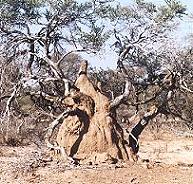Very
often we receive a requests and questions on malaria - where, when and how to protect
yourself. We decided to publish this information from Ministry of Health and Social
Services of Namibia as a short guideline for your reference.
Introduction
Malaria in Namibia is mainly found in the Northern areas
of the country, although it has also been reported in the central region and occasionally
in the South. Malaria can be serious and fatal decease without prompt treatment.
Malaria is transmitted by the bite of an infective mosquito, which usually bites
after dark.
Tourists in Namibia can help to reduce the risk of malaria by using personal
protection measures and prophylaxis.
Symptoms
Fever, rigors (shivering), headaches, backaches,
diarrhoea and/or vomiting and malaise.
Personal protection measures
The following measures are effective in reducing the
risk of mosquito bites:
* Sleeping under a mosquito bednet when mosquitoes are active at night, especially
between 20:00 - 6:00 h. Nets treated with harmless insecticides will further
increase protection. Bednets are available in the local shops.
* If possible avoid outgoing between dusk and dawn, when mosquitoes commonly bite.
* Wearing long sleeved clothing and trousers. Dark colours attract mosquitoes.
* Burning coils and pellets containing the insect repellent pyrethrum.
* Applying mosquito repellents to exposed skin and clothing. Those containing
diethyl toluamide (deet) or dimethyl phthalate are the best.
* Using insecticide sprays is effective if entry of mosquitoes into the room is
prevented.
* Sleeping in rooms with windows and doors screened with mosquito
netting. Keep windows and doors closed.
Prophylaxis
The World Health Organisation's recommendation for
travellers to Namibia and from non - malarious areas within Namibia is Chloroquine and
Proguanil.
Chloroquine
Adults (including pregnant women) - 2 tablets weekly
(300 mg base), beginning one week before start travelling, continuing once weekly while in
the malarious area and for six weeks after leaving the malarious area.
Children: 5 mg/kg body weight taken at the same intervals as per adults.
Fully breastfed babies - half the recommended dose for children (2.5 mg /kg).
Partially breastfed babies (less than four feeds per day) - the full recommended
dose for children.
Proguanil
Adults (including pregnant women) -
tablets daily (200 mg base), beginning one day before travel, continuing daily while in
the malarious area and for six weeks after leaving the malarious area.
Children: 3 mg/kg body weight taken at the same intervals as per adults.
Fully breastfed babies - half the recommended dose for children (1.5 mg /kg).
Partially breastfed babies (less than four feeds per day) - the full recom- mended
dose for children.
Proguanil is to be used in addition to Chloroquine and not as an alternative.
It is always advisable to consult your doctor before beginning of
prophilaxis. Prophylaxis may not provide complete protection against malaria, particularly
with the spread of chloroquine resistant Plasodium falciparum malaria.
If you follow these precautions the risk will
be small and
nothing else will spoil enjoyment of your trip.
To print this page press Ctrl-P |

Termite hill on the territory of Epako Game
lodge near Omaruru
Directory page
Windhoek city tours
Tours to game farms
Lions, leopards, cheetahs
Tours to the Atlantic Coast
Other tours
Flights and fly-in safaris
Our safaris
Hunting
Fishing trips
Hot air balloon safaris
Self-drive tours
 Budget
camping tours Budget
camping tours
Conference services
Car rental
Chauffeur services
Other products and services
Rent-a-guide
What's new
Paul Graetz tour
Desert Express
Intu Africa lodge
Health information
African
Art on-line souvenir shop
Links to sites
on Namibia
Travel links
10 reasons to visit Namibia
Namibia information
Adventure in Namibia
Diplomatic missions in Namibia
Airlines to Namibia
People of Namibia
Did you know?
Terms and conditions
Visitors book
Pictures
Message board
Privacy statement
E-mail |
